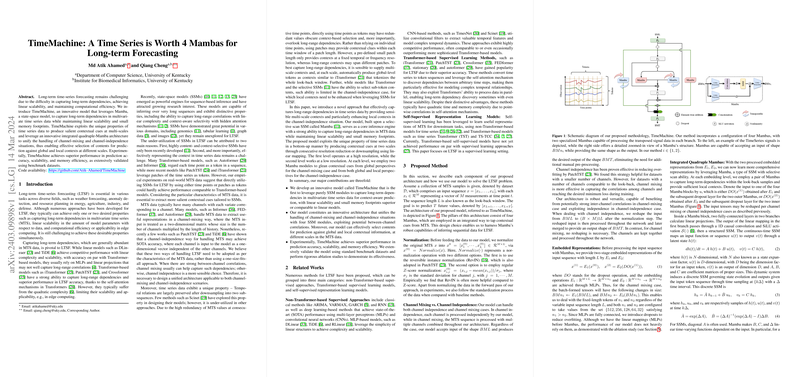Exploring the Frontiers of Long-term Time-series Forecasting with TimeMachine
Introduction
The domain of long-term time-series forecasting (LTSF) is etched with myriad challenges, primary among them being the effective capture of long-term dependencies in multivariate time series (MTS), ensuring linear scalability and computational efficiency in model design. The recently introduced TimeMachine model marks a significant stride in addressing these challenges. TimeMachine employs a uniquely designed architecture integrating Mamba, a state-space model (SSM), to efficiently handle long-term dependencies in MTS data. This model not only excels in prediction accuracy but also offers linear scalability and commendability in memory efficiency.
Theoretical Background and Methodology
TimeMachine's foundation lies in the adept exploitation of SSMs' potential to infer sequences over extended periods. Its methodological novelty is encapsulated in the development of an integrated architecture, featuring quadruple Mamba modules. This design is purposefully crafted to address both channel-mixing and channel-independence scenarios in MTS data. By drawing on the unique sequential patterns of time series data, TimeMachine constructs salient contextual cues across multiple scales.
The architecture's crux revolves around two levels of representation, each processed by a pair of Mamba modules. These modules are fine-tuned to sift through global and local contexts, thereby enriching the model with robust predictive capabilities. The model's efficiency is significantly bolstered through a strategic design that minimizes memory footprints while enhancing scalability—attributes primarily attributed to the selective prowess of Mamba modules.
Empirical Validation and Results
The efficacy of the TimeMachine model was rigorously evaluated across benchmark datasets in the LTSF domain, including Weather, Traffic, and Electricity, among others. Its performance was pitted against state-of-the-art models such as iTransformer and PatchTST, revealing TimeMachine's superior capabilities in forecasting accuracy.
Notable findings from these experiments highlight TimeMachine's commendable scalability and memory efficiency, aspects where it noticeably outperforms its counterparts. Particularly in scenarios demanding the processing of MTS data with a considerable number of channels, TimeMachine demonstrates exceptional adeptness, further consolidating its position as a method of choice for LTSF tasks.
Discussion and Implications
The TimeMachine model introduces an innovative approach to LTSF, leveraging the advantages of SSMs in a methodically designed architecture conducive to both channel-mixing and channel-independence scenarios. Its ability to capture long-term dependencies with refined precision, coupled with the scalability and memory efficiency it offers, paves the way for broader applications in various fields reliant on accurate and efficient LTSF.
The practical implications of TimeMachine extend across diverse domains, including but not limited to, weather forecasting, anomaly detection in networks, and strategic planning in energy and agriculture sectors. Moreover, the theoretical contributions of this work shed light on the untapped potential of SSMs in time series forecasting, encouraging further exploration into their capabilities.
Future Directions
While the current iteration of TimeMachine heralds significant advancements in LTSF, the quest for optimization and broadened applicability remains. Future research avenues could explore the integration of TimeMachine in a self-supervised learning framework to further enhance its forecasting prowess. Additionally, tailoring the model to cater to real-time forecasting needs in edge computing scenarios could significantly widen its application spectrum.
In conclusion, TimeMachine stands as a testament to the innovative application of SSMs in tackling the intrinsic complexities of LTSF. Its successful amalgamation of accuracy, scalability, and efficiency heralds a promising direction for future research and applications in the domain of time series forecasting.
